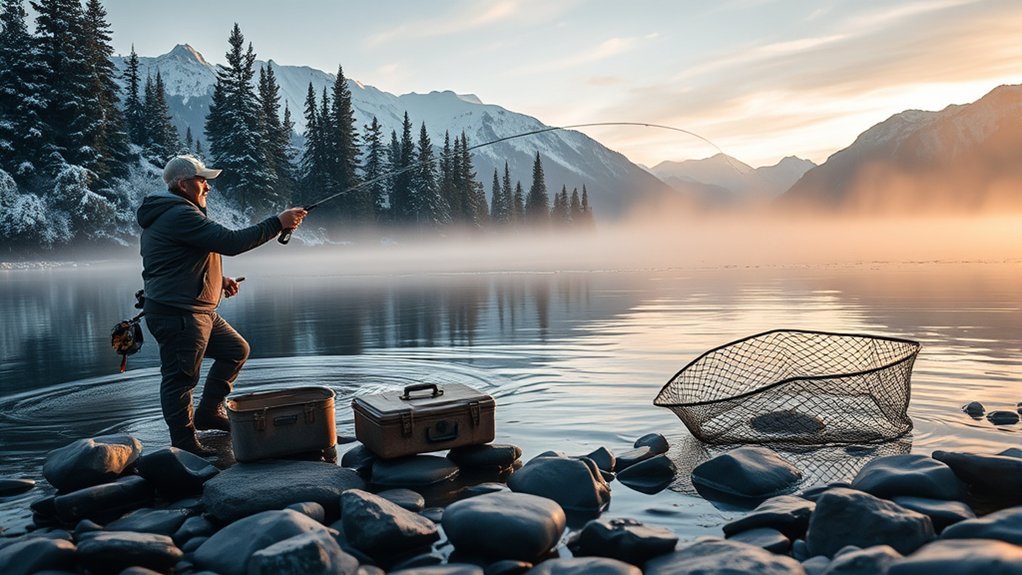If you’re an Alaska resident, you’ll pay $20 for an annual sport fishing license that funds fishery management, habitat work and access programs; non‑residents pay $145 for an annual license with shorter-duration options available (1‑, 3‑, 7‑, 14‑day) at lower rates. Special reduced or $0.50 fees exist for low‑income residents and people with disabilities, and a $10 King Salmon stamp is required to target that species; continue for details on stamps, harvest cards and purchase options.
Who Needs an Alaska Fishing License
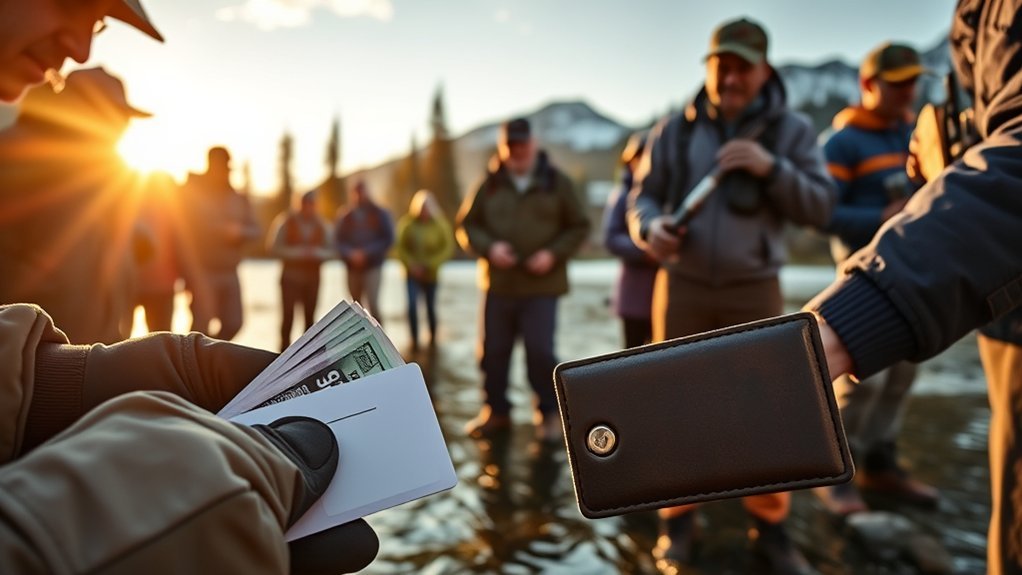
If you plan to fish in Alaska, you’ll generally need a valid license: residents 18 and older and non‑residents 16 and older must hold an Alaska fishing license for all fresh and saltwater fishing, while resident children under 18 and non‑resident children under 16 are exempt.
You’ll follow clear fishing regulations that hinge on age requirements and residency status, so verify which category applies before you cast. Residents aged 18+ and non‑residents aged 16+ must purchase licenses; exemptions reduce administrative burden for youth and support access.
Specific policy exceptions exist for qualifying residents with disabilities or low income, who may receive free or reduced-cost licenses, aligning equity goals with conservation funding.
If you plan to target King Salmon, you’ll also need a mandatory King Salmon Stamp in addition to your base license.
Adhering to these rules guarantees you’re compliant, helps fund stock assessments and habitat protection, and maintains sustainable fisheries for future seasons.
Resident License Types and Costs

One clear way Alaska balances access and conservation is through tiered resident licensing: the annual sport fishing license costs $20 and covers all species in fresh and salt waters, while reduced-fee options target seniors, low-income residents, and people with disabilities.
You’ll find clear, data-driven policy choices: residents 60+ get an ADF&G Permanent Senior ID Card free and exempt from licensing; low-income residents pay $5 for a special license; residents with disabilities pay $0.50, maximizing accessibility while sustaining revenue.
You must also purchase a $10 King Salmon Stamp if you plan to fish for that species, reflecting species-specific conservation finance.
These fee differentials signal policy priorities—equity, targeted revenue, and species protection—and create tangible license benefits like legal compliance, participation in regulated harvests, and funding for habitat management.
Non‑Resident License Options and Pricing
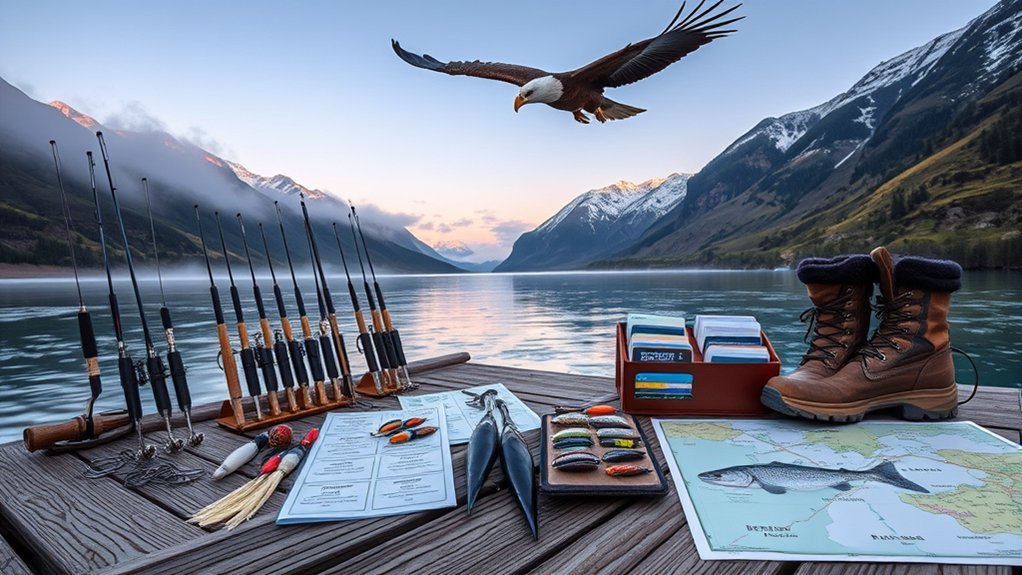
Non-resident anglers have flexible, duration-based license options that balance accessibility with conservation funding: you can buy a 1-day license for $25, 3-day for $45, 7-day for $70, 14-day for $105, or an annual license for $145, all valid for fresh and saltwater fishing.
You’ll choose fishing duration options based on trip length and management objectives; short-term choices lower upfront cost while the annual supports sustained conservation funding. Yukon Territory residents can buy non-resident licenses at resident prices, reducing barriers and encouraging cross-border compliance.
Non-residents can’t access low-income or blind license types, so your primary tool is selecting an appropriate duration or the annual license for frequent angling. Note that some species require additional permissions; planning should budget for stamps and species endorsements.
From a policy standpoint, duration-based fees are transparent revenue mechanisms that tie use to resource stewardship. Track the license renewal process proactively to avoid gaps in coverage and guarantee regulatory compliance during your fishing season.
King Salmon Stamps and Harvest Card Rules
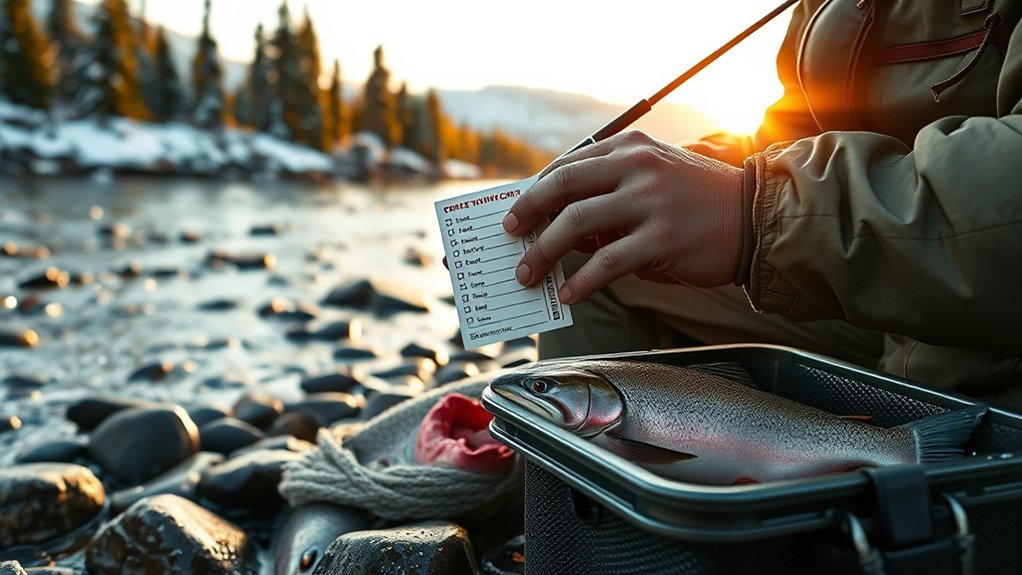
After choosing a license duration, you’ll also need to account for species-specific permissions and reporting: anglers who fish for or retain King (Chinook) Salmon must buy a King Salmon Stamp in addition to their fishing license, with non-resident one-day stamps priced at $15 and resident stamps at $10.
You’ll be required to purchase the stamp whenever you intend to target king salmon; non-residents must buy it regardless of license length. Compliance also requires a free Harvest Card to document fish taken under annual limits.
Even if you’re exempt from a license due to age (residents under 18, non-residents under 16), you still need a harvest card when pursuing species with quotas, including king salmon. Harvest Cards are typically issued by guides or printable online; you must record each take accurately to support quota monitoring and enforcement.
Age-exempt anglers still need a harvest card for quota species like king salmon and must accurately record each take.
Following these rules preserves stock data, informs management decisions, and reduces the need for restrictive measures that could limit future angling opportunity.
Where and How to Buy Your License
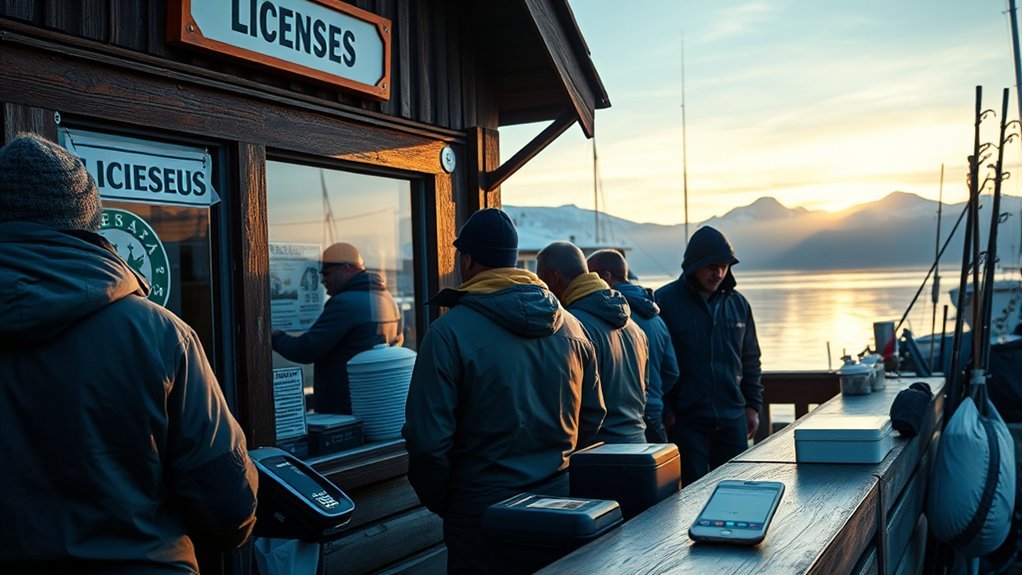
You can buy Alaska fishing licenses online through the Alaska Department of Fish and Game website for the fastest, most reliable option, or pick them up in person at local retailers like Sportsman’s Warehouse and Walmart in the Soldotna/Kenai area if you prefer a physical purchase.
You’ll find online purchasing supports immediate issuance of electronic licenses usable on mobile devices, eliminating mandatory paper copies and reducing administrative overhead. Residents and non-residents can choose term-specific options; non-resident short-term licenses (1-, 3-, 7-, 14-day) provide flexibility for targeted management and revenue allocation.
If you lose your license, obtain a duplicate for $5.00 to remain compliant with enforcement protocols. Use local stores when you need in-person assistance, receipts, or gear, but rely on the department site for up-to-date regulatory notices, harvest card integration, and conservation fee allocation details.
Choosing the appropriate channel helps enforce regulations, funds habitat protection, and keeps harvest data accurate for sustainable fishery management.
Frequently Asked Questions
Do I Need a License for Fishing From a Charter Boat?
Yes — you still need a license when fishing from a charter boat unless state exceptions apply. Follow charter boat regulations and fishing permit requirements; check Alaska Fish & Game policies to verify compliance and support sustainable, conservation-minded management.
Are There Discounts for Seniors or Military?
Yes — you can get reduced rates: Alaska offers senior discounts and military benefits for licenses, with specific age, residency and service verification required; check ADF&G policy tables and documentation for precise fee schedules and conservation conditions.
How Long Is an Annual License Valid?
An annual license is valid for one year from issue date, and you’ll need timely license renewal before expiry; policies guarantee compliance with seasons, data-driven limits, and conservation goals to protect fishery sustainability.
Can I Fish on Federal Lands Without an Alaska License?
Yes — you can fish on some federal lands without an Alaska license, but regulations vary; consult fishing regulations maps and agency rules, prioritize conservation, and follow permit, species, and season restrictions to avoid penalties.
Are There Penalties for Lending My Fishing License?
Yes — you can face fines and citation: license sharing is prohibited, and legal repercussions include monetary penalties and possible loss of fishing privileges; data and agency policy treat this as enforcement to protect conservation and resource management.
Conclusion
You’ve seen who needs a license, the resident and non‑resident prices, and king salmon stamp and harvest card rules—now decide responsibly. Will you buy the right permit and follow harvest limits to protect stocks for future anglers? Choosing the correct license supports management, enforcement, and conservation funding. Check current fees and stamp requirements before you fish, purchase through official channels, and report harvests accurately to guarantee sustainable fisheries and sound policy outcomes.

